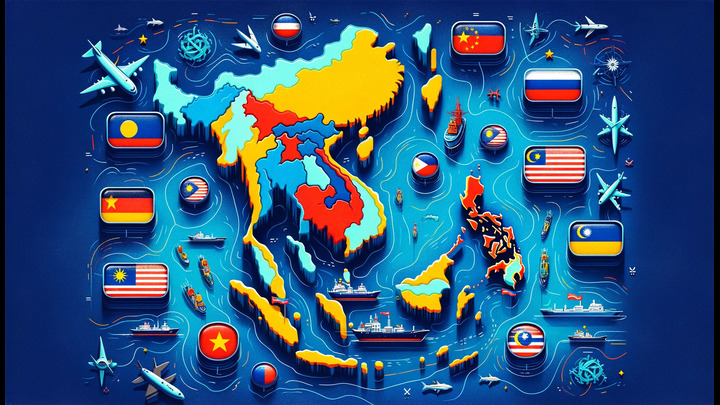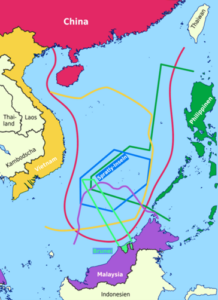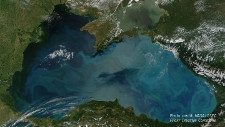Strategic Standoffs: How Repeated Games Illuminate the Future of South China Sea Disputes

Brian Iselin
Introduction
The motivation to put this piece together was observing the recent bizarre and, dare I say, childish behaviour of the Chinese Coast Guard in the South China Sea (SCS), firing water cannons at a Philippines’ Coast Guard vessel. It is the equivalent of turning your garden hose on the neighbour because his dog is barking. While they damaged it slightly, what they really did was undermine confidence, a rare commodity in the region. This niggling behaviour cannot solve anything, of course; it just makes the region more unsafe, bit by bit. For the mutual confidence needed to solve the SCS issue, such behaviour is death by a thousand cuts – 凌遲. If there had been an actor turning the hose on its neighbour in any other shared waterway in the world, we would not have any shared waterways.
This childishness being displayed in otherwise very serious, very sensitive, geopolitics made me wonder how to get everyone to play more nicely on the SCS issue which, for many decades now, has been a festering global flashpoint. And it occurred to me that perhaps we could learn something about it using games theory, in particular Repeated Game Theory (RGT). So, with that goal in mind, let’s take a look.
The SCS, characterised by its strategic maritime routes and significant oil and gas reserves, has long been a focal point of the kind of intense geopolitical tensions mentioned above. Several nations, including China, Vietnam, the Philippines, Malaysia, Brunei, and Taiwan, assert overlapping territorial claims that complicate the regional security landscape. In this article I dip a toe in RGT to analyse these ongoing conflicts, hoping to provide a unique lens through which to view both current tensions and future possibilities.
RGT, a branch of game theory, jumped out at me as having potential precisely because of the many decades this cold conflict has been going on. RGT examines situations where players encounter the same or similar decisions repeatedly over time. By analysing how interactions evolve over an extended period, this theory helps us understand the conditions under which cooperation or conflict emerges and stabilises. Given the cyclical nature of diplomatic and military standoffs in the South China Sea, RGT might offer us valuable insights into the strategic calculations of the involved states.
In applying this theoretical framework, I want to not only clarify the underlying dynamics of the SCS dispute but also to try to forecast future developments. By understanding the repeated nature of these interactions, policymakers might better anticipate the move choices on this chessboard, potentially leading to more informed and effective strategies for managing or resolving disputes. Note that this is a simple blog post, so I touch just the surface in this all-too brief analysis. There is much more to do but it feels there is reason to explore it further.
Background and Current Dynamics
The SCS, spanning roughly 3.5 million square kilometres and hosting one-third of the world’s maritime shipping, is not only a vital artery for international trade but also a hotbed of territorial disputes that challenge regional stability. The area is claimed by the six countries indicated earlier: China, Vietnam, the Philippines, Malaysia, Brunei, and Taiwan. These claims are primarily driven by the region’s strategic geographic position and rich natural resources, including estimated billions of barrels of untapped oil and trillions of cubic feet of natural gas.
Historical Context
The roots of these disputes trace back to the mid-20th century, but intensified interest has been evident since the 1970s when significant hydrocarbon resources were discovered. While numerous of the parties in conflict point to maps from deep history, the region really only became this flashpoint with this discovery of oil equivalents under the SCS. So, while oil is not the only determinant now, it was the one to put the region on the global volatility scoreboard. The United Nations Convention on the Law of the Sea (UNCLOS), established to regulate maritime boundaries, has not fully resolved these disputes due to differing interpretations and claims based on historical rights versus UNCLOS provisions. As you can see from the map below, some claims seem perfectly reasonable for their coastal proximity, and some seem outlandish or even extreme. These extremes of course do not help us with game theory in general as that is fundamentally based on rational actors. Clearly that is not what we are dealing with here. But it this irrationality of the actors that leads me to think RGT perhaps can help us where standard games theory cannot.

1: A map of competing claims in the SCS, overlaid on gas/oil fields. (Source: southchinesea.org )
China’s claims, marked by the “Nine-Dash Line,” encompass the majority of the SCS and overlap with the Exclusive Economic Zones (EEZs) of other countries, leading to numerous standoffs. For instance, the Spratly Islands and Paracel Islands have been centres of military and fishing skirmishes for many deacdes, drawing in not just the claimant states but also extra-regional powers interested in maintaining freedom of navigation. Notably, more “islands” have been popping up all over the place as China simply builds new ones wherever it seeks to improve or extend its claims.
Fossil Fuel Dependence
A large part of what is happening on top of the water is because of what lies under the water; the enormous reserves of fossil fuels – oil and natural gas – I mentioned earlier. While not being the whole story, fossil fuel dependence and income are crucial determinants of the behaviour of SCS littoral states. The countries involved are significantly influenced by those fossil fuel reserves, but their dependence on these resources now, and in the future varies considerably based on their energy needs, economic structures, and new energy resources. Here’s a closer look at how these countries are impacted by and depend on fossil fuels, and some projected changes in this dynamic:
China
- Dependence Level: High. China is one of the world’s largest consumers of energy, including fossil fuels. The SCS is viewed as a critical source of oil and natural gas, which could support China’s energy needs and help reduce its reliance on imports.
- Future Outlook: China is aggressively investing in renewable energy technologies, but its enormous energy demand means that fossil fuels will remain a significant part of its energy mix in the near future. China’s energy policy includes strong elements of diversification and securing energy routes, which includes the SCS. At the same time, China is also making significant discoveries of its own fossil fuels. For example, the recent Bozhong 26-6 discovery under the Bohai Sea; perhaps the world’s largest fossil fuel reserves at more than 100 million tons of oil equivalent, might end up yielding more than 20 million tons of crude oil and more than 9 billion cubic meters of natural gas.
Vietnam
- Dependence Level: Moderate to high. Vietnam relies heavily on fossil fuels, especially oil and gas. The country has actively developed offshore oil fields in the SCS, despite disputes and tensions with China.
- Future Outlook: Vietnam is exploring renewable energy options, but its growing economy and energy demands likely mean continued reliance on fossil fuels for some time. The contested resources in the SCS are crucial for Vietnam’s energy strategy.
Philippines
- Dependence Level: Moderate. The Philippines has some domestic oil production but relies heavily on imports to meet its energy needs. The potential resources in the SCS represent a significant opportunity for the Philippines to increase its energy security.
- Future Outlook: The Philippines is increasing investments in renewable energy but, like its neighbours, will continue to need fossil fuel resources for the foreseeable future, particularly for transportation and industrial sectors.
Malaysia and Brunei
- Dependence Level:
- Malaysia: Moderate. Malaysia is a net exporter of oil and natural gas, and the SCS contributes significantly to its economy.
- Brunei: High. Brunei’s economy is heavily dependent on revenues from oil and gas exports, much of which comes from the SCS.
- Future Outlook: Both countries are likely to remain dependent on fossil fuels, although Malaysia is making more significant strides in integrating renewable energy into its grid than Brunei. Their economies are closely tied to the exploitation of near offshore resources.
Taiwan
- Dependence Level: Moderate. Taiwan imports more than 90% of its energy needs and, while it does not have a significant direct stake in the fossil fuels of the SCS, the security of energy routes through the region is a critical concern.
- Future Outlook: Taiwan is actively transitioning to renewable energy, with ambitious targets to decrease nuclear power and fossil fuels. However, energy security remains a priority, influencing its interest in the region.
Change in Fossil Fuel Dependency
The extent of dependence on fossil fuels in all of these countries will change as global energy markets shift towards renewables, and as these countries adopt new technologies and policies aimed at reducing carbon emissions. The faster any of the SCS littoral states realise their green transition, the lower their need to enjoin the conflict. Although, as I said before, fossil fuel access is only one (albeit crucial) determinant of behaviour. China is the only one making significant other finds for the moment; one wonders when or if that will impact the SCS claims. China needs to first wean itself off Russian oil, which is also very interesting strategically. New finds like Bozhong 26-6 may actually make China a net exporter in competition with Russia in the not-so-distant future.
However, any renewable transitions of SCS littoral states will be gradual. The geopolitical importance of the SCS, including its fossil fuel resources, is likely to remain significant in the near to medium term, especially as energy transitions take time and investments.
Recent Incidents
Recent years have seen an escalation in confrontations. Notably, China’s construction of artificial islands and its militarisation of these features have sparked significant international debate and concern. Incidents such as the 2012 Scarborough Shoal standoff between the Philippines and China, and the ongoing confrontations involving Vietnamese and Chinese vessels, and Philippines and Chinese vessels, underscore the volatile nature of this region.
In 2019, a Vietnamese fishing boat sank near the Paracel Islands after a collision with a Chinese vessel, an incident that Vietnam protested as a violation of its sovereignty. Similarly, in 2020, Malaysia and China had a month-long maritime standoff that began when a Chinese survey ship entered waters near Malaysia’s EEZ, accompanied by Chinese Coast Guard and fishing vessels. And then there was this recent puerile water cannon caper.
China’s dramatic transition from having a navy largely comprising brown water vessels is also a determinant of behaviour in the SCS. Growing its blue water navy at a dramatic rate gives them a power projection capability they did not have 15, or even 10, years ago. Parking one of their three aircraft carriers down the farthest end of the SCS is not any longer an improbability.
Strategic Importance
These incidents are not isolated events but are part of a broader strategic game wherein each state seeks to maximise its gains while minimising losses. The strategic importance of the SCS extends beyond resource acquisition to include significant military interests. Control over the region allows for the projection of military power and the ability to monitor and potentially control one of the world’s busiest maritime routes. This might be seen by China as a self-defence measure, but everyone else sees it as provocative and paranoiac.
As the transition towards greener energy sources progresses, optimistically (probably overly so) some with claims might decide to stand back a little, but then other motives will likely take on greater significance in shaping the region’s geopolitical dynamics. Here’s a breakdown of these additional factors:
Strategic Military Importance
- Control of Major Shipping Lanes: The SCS is one of the most significant maritime passages in the world, with about 1/3rd of global shipping passing through its waters. Control over these waters is not only economically beneficial but also provides significant strategic military advantages. Think if one country had control of the Suez or Panama Canals, or the Red Sea, even.
- Military Presence: The ability to establish military bases on the islands and in the region offers significant strategic depth and area denial capabilities. Given the considerable distance China’s claim is from its one territory, and how close it is to everyone else’s, means China needs more than any of the others to take more significant militarisation (blue water) steps to grow control. There can be little doubt that a part of China’s calculus for their third aircraft carrier is to allow air supremacy over the entire SCS. This military presence can be used to project power far beyond China’s borders and secure sea lines of communication.
Economic Interests
- Fishing Rights: The SCS is rich in marine biodiversity, providing crucial fisheries that are vital for the food security and economic livelihood of millions in the region. Control over these waters can secure exclusive access to these resources.
- Maritime Resources: Apart from fossil fuels, the SCS potentially holds other valuable underwater mineral deposits. Securing these resources can be economically significant.
Nationalistic and Sovereignty Issues
- Territorial Integrity: For many of the claimant states, sovereignty claims over parts of the SCS are tied to national identity and historical rights. National pride and the political imperative to not appear weak domestically reinforce these claims.
- Historical Claims: The disputes involve historical grievances and narratives that complicate diplomatic solutions. For example, China’s “Nine-Dash Line” is based on maps from the early 20th century, which it uses to justify its claims over the vast majority of the sea.
Regional Influence and International Law
- Regional Dominance: Control over the SCS enhances a country’s influence in Southeast Asia, which is pivotal for regional leadership. This dominance is not just military or economic but also diplomatic.
- UNCLOS and International Norms: The United Nations Convention on the Law of the Sea (UNCLOS) plays a crucial role in shaping international maritime law. How countries align with or challenge UNCLOS influences their standing and relations internationally.
Future Security Concerns
- Buffer Against External Powers: For China, ensuring control over the SCS is seen as a buffer against the influence of the United States and its allies in the region. The SCS is viewed as a critical front in the broader strategic competition with the U.S.
- Precedence for Future Conflicts: The outcome of the SCS dispute could set a precedent for how maritime disputes are resolved worldwide, impacting global maritime strategy and international law.
The SCS is a live chessboard where energy resources are just one set of stakes. The region’s importance spans strategic military advantages, economic benefits from maritime and fishing resources, nationalistic sentiments tied to territorial sovereignty, and broader regional influence. These elements make the SCS a persistent hotbed of geopolitical tension.
Given this complex backdrop, can RGT offer a valuable framework for understanding the persistent nature of these disputes and the strategic behaviours of the involved states?
RGT: An Overview
Fundamentals of RGT
RGT, a critical branch of game theory, focuses on scenarios where the same game is played multiple times, allowing players to adjust their strategies based on past outcomes. In these games, the decisions of each player in each round are influenced by the results of previous rounds, which can significantly alter the strategic landscape over time. This adaptability of strategies, depending on the game’s history, enables the analysis of long-term strategic interactions among players.
Key Concepts
- Nash Equilibrium: This is a situation in a game where no player can benefit by changing strategies while the other players keep theirs unchanged. In RGT, multiple Nash Equilibria can exist, particularly as what are called cooperation or defection strategies evolve.
- Cooperation vs. Defection: In the context of international relations, cooperation might involve abiding by treaties or informal agreements, while defection could involve breaches of these agreements. RGT means we can analyse under what conditions cooperation is likely to sustain over defection.
- Punishment Strategies: These are strategies that can enforce cooperation in repeated games. If a player defects, other players might retaliate in future rounds, thus creating a deterrence against defection.
- Tit-for-Tat Strategy: This involves playing cooperatively at first, then replicating an opponent’s previous action. If the opponent cooperates, so do you; if they defect, you retaliate similarly in the next round. This strategy has been effective in various diplomatic and economic contexts.
Examples in International Relations
Historical instances, such as the Cold War dynamics between the USA and the Soviet Union, have been analysed through RGT. The alternating cooperative and defection strategies shaped the prolonged periods of tension and détente, providing insights into how long-term engagements are managed.
Application of RGT to South China Sea
Theoretical Analysis of the Conflict
Applying RGT to the South China Sea disputes involves examining how the involved states have historically interacted over claims and how these interactions inform future engagements. Each round of conflict or cooperation can be seen as a separate game, influencing the subsequent decisions made by these countries.
Creating Payoff Matrices
To analyse these dynamics, we can construct payoff matrices (the standard choice/options mapping tool for games theory) for different scenarios—such as negotiations, military skirmishes, or unilateral actions like island-building. These matrices help in understanding the potential benefits and costs to each player depending on various cooperative or confrontational approaches.
- Example of a Payoff Matrix: Consider a scenario where two states, State A and State B, choose between militarisation (defection) and negotiation (cooperation). The payoff for militarisation might be high in terms of immediate strategic advantage but low concerning international reputation and future negotiation potential. Conversely, negotiation might offer moderate but stable long-term benefits, fostering more predictable and secure relations.
Case Studies
- The Scarborough Shoal Standoff: Analysing the standoff between China and the Philippines through RGT shows a pattern where short-term gains from aggressive tactics potentially lead to long-term instability and increased international scrutiny.
- The Paracel Islands Confrontation: Here, repeated confrontations might create a cycle where immediate tactical victories by one party lead to prolonged regional insecurity, influencing future rounds of the game.
Insights from Repeated Interactions
The history of claims and conflicts in the South China Sea suggests a repeated game where defection has often been met with either direct retaliation or increased militarisation by others. These dynamics indicate that while short-term defection (such as through island building or naval confrontations) may seem beneficial, they could lead to less cooperative and more volatile future interactions, thereby increasing the overall instability in the region.
In the context of RGT, the most recent incident mentioned earlier, where Chinese Coast Guard vessels “hosed down” a Philippines Coast Guard vessel, can be analysed as part of a larger pattern of strategic interactions in the South China Sea, reflecting the dynamics of cooperation and defection among the involved parties. We may do this every time a new incident of note emerges, as each is a further behaviour that influences future behaviours. Here’s how RGT can help explain what happened in the “hosing down” incident:
Strategic Signalling and Reputation Building
- Defection as a Strategy: In this incident, the action by the Chinese Coast Guard could be seen as a defection from cooperative norms of maritime behaviour, which generally discourage aggressive actions that could lead to escalation. By choosing defection, China is signalling its resolve and commitment to defending what it perceives as its sovereign territory. This defection is calculated by China to contribute to building a reputation for toughness, potentially deterring other nations from challenging its claims.
- Response to Past Interactions: The choice of defection could also be influenced by previous interactions in the area. If past actions by the Philippines (or other nations) were perceived by China as hostile or as challenges to its claims, the “hosing down” incident can be seen as a retaliatory measure within the framework of a Tit-for-Tat strategy. This strategy, where a player replicates an opponent’s previous action, is common in repeated games, where each game is not played in isolation but as part of an ongoing series of interactions.
Maintenance of Status Quo Through Controlled Aggression
- Balancing Aggression and Avoidance of Full-Scale Conflict: The use of non-lethal force (like hosing down rather than using live fire) suggests a calculated approach to maintain pressure without triggering a serious military response. The use of Coast Guard vessels instead of destroyers is a function of this calculus. In RGT, this can be viewed as an attempt to influence future games. By not escalating to lethal force, China maintains ongoing engagement in the game while setting the terms of engagement, which includes demonstrating capability and will without crossing a threshold that would necessitate an international military response.
Impact on Future Rounds
- Influencing Future Interactions: China’s defection will impact future interactions in the region. The Philippines, and possibly other stakeholders in the South China Sea, must now consider this event in their future strategic calculations. The incident might deter future Philippine actions that could provoke China, or it might galvanise a stronger collective response from other Southeast Asian nations or external actors like the United States.
- Long-Term Strategy: From a repeated games perspective, China might be assessing the payoff from such actions over the long term. If the strategy secures incremental advantages without significant costs (such as international sanctions or military retaliation), it might be seen as a successful approach, reinforcing similar “niggling” strategies in the future.
RGT helps us understand that such incidents are not isolated but are part of a broader strategic environment where past actions and future expectations influence current decisions. Each interaction helps define the rules of the game and sets the stage for future rounds, where players continuously adjust their strategies based on the outcomes and behaviours of their opponents. Thus, the “hosing down” incident is a move in a much larger and continuing game of strategic interaction in the South China Sea, reflecting ongoing patterns of cooperation, defection, and retaliation.
Implications for Future Policy
Strategic Recommendations
Using insights from RGT, policymakers can develop strategies that emphasise long-term cooperation and stability over short-term tactical gains. Encouraging multilateral negotiations, establishing conflict-resolution mechanisms, and promoting transparency can be effective in fostering a cooperative regional environment.
Predictions Based on Theoretical Outcomes
RGT suggests that if current patterns of defection continue, the South China Sea might see escalating tensions, potentially leading to more severe conflicts. More defections will only lead to more defections. Conversely, if states can shift towards cooperative strategies, supported by international legal frameworks and regional agreements, there might be a gradual stabilisation of the situation. Confidence-building measures are essential to walk back the mistrust engendered by defections.
Conclusion
RGT offers a robust framework for analysing complex international disputes where historical grievances and future aspirations are deeply intertwined. In the context of the SCS, this approach highlights the importance of understanding the long-term consequences of actions taken today. It suggests that while defection might offer immediate advantages in terms of territorial control or resource access, the long-term costs of such strategies can be substantial, leading to increased tensions and the possibility of conflict escalation. One can only turn the hose on one’s neighbour so many times before the neighbour retaliates.
Moreover, RGT underscores the potential for cooperation. RGT unveils patterns of behaviour. By identifying and understanding the cycles of conflict and cooperation, states can better navigate the tensions and work towards sustainable and peaceful resolutions. RGT points to the effectiveness of strategies like Tit-for-Tat, which can promote reciprocity and mutual respect, potentially guiding the region away from conflict and towards a more cooperative future.
Limitations of the Approach
While RGT provides significant insights, it also has limitations. The theory does still a modicum of rational decision-making, which may not always apply in the real world where national pride, miscommunication, and irrational actors can influence outcomes. A defection might in fact be a result of communication breakdowns, bad orders, or insanity, as much as a calculated move. There are precedents. The complexity of international relations, involving multiple stakeholders with varying interests, can make it challenging to predict behaviours purely through theoretical models.
Call for Further Research
Given the evolving nature of the SCS disputes and the complexity of international relations, continuous research is necessary. Academics and policymakers should collaborate to refine the applications of game theory in geopolitical analysis, incorporating more dynamic variables and perhaps integrating other theoretical frameworks. Such ongoing study will be crucial in devising more effective strategies for conflict management and resolution.
Engaging the International Community
The insights derived from RGT should serve as a call to action for the international community. By better understanding the strategic games at play, global leaders and regional stakeholders can work together more effectively to address the challenges in the SCS. Promoting dialogue, enhancing mutual understanding, and committing to multilateralism are essential steps toward achieving lasting peace and stability in the region.
References
Axelrod, R. (1984). The Evolution of Cooperation. Basic Books.
Fudenberg, D., & Tirole, J. (1991). Game Theory. MIT Press.
Oye, K. A. (Ed.). (1986). Cooperation Under Anarchy. Princeton University Press.
Weissmann, M. (2015). The South China Sea Conflict and Sino-ASEAN Relations: A study in conflict prevention and peace building. Asian Perspective, 39(4), 563-586.
Schelling, T. C. (1960). The Strategy of Conflict. Harvard University Press.
Mearsheimer, J. J. (2001). The Tragedy of Great Power Politics. W.W. Norton & Company.
Glaser, C. L. (2010). Rational Theory of International Politics: The Logic of Competition and Cooperation. Princeton University Press.
Valencia, M. J. (Ed.). (2005). The Proliferation Security Initiative: Making Waves in Asia. Routledge.
Related Publications
-
China as a Black Sea Actor: An Alternate Route
China’s international role has expanded rapidly in the last decades, and the Greater Central Asian region, Europe, and the Middle East, to which the Black Sea region (BSR) connects, are […]
-
Taiwan-PRC Crisis: What Cross-Strait Conflict Could Cost Europe
The escalating tensions between Taiwan and China pose significant economic and strategic challenges to the European Union, such as the inaccessibility of Taiwanese inputs, market, and capital. This issue brief […]
-
Taiwan and the Diplomatic Squeeze
In mid-March 2023, the self-governing island of Taiwan lost another one of its already few diplomatic allies. Announcing the severing of diplomatic ties between Taiwan and Honduras on Twitter on March 15, […]
-
ASEAN’s Evolving Alignment Strategy in the South China Sea: Between Middle and Major Power Dynamics
ASEAN is a region of vital strategic importance where the United States’ Indo-Pacific strategy and China’s Belt and Road Initiative (BRI) collide. To avert geopolitical uncertainty and to avoid being […]
-
Navigating the Indo-Pacific: How Australia and the EU Can Partner for Peace, Stability, and Prosperity
To navigate the choppy waters of the Indo-Pacific, the EU and Australia must be on the same wavelength regarding shared interests in rules, values, and an open and liberal economic […]




